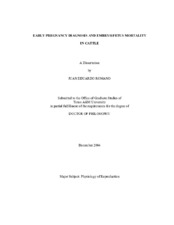| dc.description.abstract | Pregnancy diagnosis by transrectal ultrasonography (using a 5 MHZ linear
probe) presented the maximum sensitivity and negative predictive values at day 26 and
day 29 after estrus in heifers and cows, respectively.
Palpation per rectum using the fetal membrane slip for pregnancy diagnosis did
not increase embryo/fetus mortality when compared with a positive control group of
non-palpated females. The use of a controlled randomized block design was a useful
approach to study this problem. Blocking for category and number of embryos allowed
us to remove these confounding factors.
Factors that affected pregnancy loss during the first four months of pregnancy
were: period of pregnancy, age of the animal, number of previous lactations and number
of embryos. Pregnancy loss was higher during the embryonic than fetal periods.
Spontaneous embryo/fetal mortality increased with the age of the animal and lactation
number. The risk of spontaneous embryo/fetus mortality was higher in twin than in
single pregnancies.
Two types of embryo/fetus mortality were noted: Type I and Type II. Type I was
characterized by presence of positive fetal membrane slip by palpation per rectum, signs
of degeneration by transrectal ultrasonography and persistence of a functional corpus
luteum. The uterus took approximately 3 weeks to be noted clean by transrectal
ultrasonography and the animals showed estrus one month after the conceptus was
diagnosed dead. Type II was characterized by absence of positive signs of pregnancy by
palpation per rectum, absence of signs of degeneration by transrectal ultrasonography
and absence of a functional corpus luteum.
Pregnancy loss in nuclear transfer derived embryos was higher compared to in
vivo derived embryos produced by artificial insemination. Pregnancy loss occurred
mainly during the transition from the embryonic to the fetal period. Embryo/fetus
mortality detected was Type I. Progesterone produced by the corpus luteum was noted at
pregnancy levels for approximately two weeks after embryo/fetus death. Protein B, a
hormonal placental marker, was maintained at pregnancy levels for approximately 3
weeks after embryo/fetus death. No differences in the levels of the two hormones were
noted when comparing females with dead or live conceptuses. | en |


